The Mach 22: Joey Logano’s Custom Mustang
During the 1960s, the Cold War’s grip on the American consciousness birthed a new aesthetic culture. Although hippies, flower power, and tie-dye received the attention, it was the space race that pushed design toward radical new frontiers. A society obsessed with technology, firepower, and speed had dramatically changed the look and message of its products, aligning them with a highly-politicized, extraterrestrial curiosity.
By 1969, this infatuation had reached a siren pitch and touched almost every American product, including the Ford Mustang. As Neil Armstrong’s boots hit the moon, the tires of a new pony car hit the streets: the Mustang Mach 1. Contrary to its name, the Mach 1 never quite reached the speed of sound, but it did give the Mustang some serious performance credentials.

Recently, 2018 NASCAR Champion Joey Logano appeared on Discovery’s “Car Kings” to work with Galpin Auto Sports (GAS) on a Mach 1 worthy of its namesake. Beau Boeckmann, president and chief operating officer of Galpin Motors Inc., along with the rest of the GAS team, set out to build a Mach 1 like no other. Wanting the best that GAS could dream up, Logano provided the team with a blank checkbook and only two requests: make it matte black and make it fast.
Dubbed the “Mach 22” in honor of Logano’s racing number, the pony car that emerged from the GAS shop is anything but domesticated.
Finding the Right Car
Logano first tasked the GAS team with finding a second-generation Mach 1 from the early 1970s. These facelift Mach 1s are wider, longer and more powerful than previous cars, all in an effort to keep the Mustang competitive with the hot-on-its-heels Chevy Camaro.When you’re looking for a car that’s a half-century-old, finding a clean example can be a tall order. The GAS team are experts at the search process for finding the rarest of the rare, however, and had no problem sourcing a 1972 Mach 1. Aside from minor body repairs on one of the rear corners, the car appeared to be in good shape.

Sometimes, a car with a clean appearance at first glance will have problems that aren’t detectable on a lift, let alone in someone’s driveway. Unfortunately, they discovered unexpected rust after disassembly. When the car’s body came back from media blasting, it was far from swiss cheese, but not quite the solid block of cheddar they initially believed they had. Dairy jokes aside, the talented guys in the GAS body shop had the Mach 1 patched up in no time and ready for its first modifications.
Stiffening the Body
In addition to performing the body repairs, the GAS team stiffened the structure of the Mustang with some choice modifications. Mustangs feature a unibody configuration, which means that the only thing connecting the front and rear suspension components is the body itself. The factory didn’t build the 1972 Mach 1 strong enough for the high-horsepower engine in its future.To help the car out, the Galpin team fitted subframe connectors, which — as their name implies — connect the front subframe to the rear subframe using two thick bars that run parallel to the car’s unibody. To take the stiffening measures to the next level, the GAS team also fitted a roll bar, which they welded to the subframe connectors below. With the body now up to the task, the Mustang was ready for stratospheric levels of horsepower.
Performance
The 1972 Mach 1 was available with several drivetrain configurations; this particular car came fitted with a 351 cubic-inch Cleveland V8. Although the powerplant’s raging 180 horsepower was top-of-the-line in 1972, anything less than 800 horsepower simply wouldn’t do for this build. Boeckmann wanted the Mach 1 to scare Logano, but when your client drives a Cup car for a living, that’s a lofty goal.Nevertheless, where there’s a will, there’s a way. The goal was to maintain somewhat of an OEM appearance under the hood. The GAS team opted for a 5.0-liter Coyote Aluminator V8 from Ford Performance and combined it with a ROUSH Performance supercharger to add extra excitement. To get the 800-plus horsepower from the Mach 1’s new heart to the wheels, the team chose a Tremec six-speed manual transmission.
When it came to mounting the engine, the GAS team ran into a setback. When lowering the engine into the chassis, they realized the Aluminator was resting on the frame rails. Not only did this mean that they’d have to build custom mounts, but it also meant that the build required custom headers and a full exhaust system.

For that exhaust system, they used MagnaFlow’s custom builder parts to develop a complete system, from the cylinder heads to the tailpipes. The exhaust system consists of MagnaFlow’s stainless steel mandrel-bent pipes, exhaust collectors, crossovers, and, of course, signature mufflers. The result is an exhaust system that not only fits well and flows plenty of air to allow the engine to breathe, but also sounds as good as it looks.
Although the original Mach 1 was designed for handling, technology has come a long way since 1972. As a result, every part of this classic was refined to give it the prowess of a modern driver’s car. To finish their performance modifications, the GAS team fitted the car with a full Chassisworks autocross suspension and Wilwood brakes at all four corners.
Styling
The Mach 1 was derived from the Mach 1 concept car, a sleek, futuristic coupe with an impossibly long front clip, flush-mount headlights, and a dramatic fastback design. The Mach 1 concept was intended as a showpiece for technology and style to show its space-age heritage. Original sketches showed plans for active aerodynamics, among other mind-blowing tech capabilities, especially for 1966. Ultimately, the production model ended up being more of a styling showcase than a technological breakthrough, but its aspirations for speed certainly shine through.The 1969 Mustang redesign pulled heavily from the Mach 1 concept, notably featuring a new roofline extended to the end of the trunk lid. The redesign also saw the Mach 1 moniker debut as a new performance package, available exclusively with the SportsRoof body. The production Mach 1 featured a matte-black hood stripe, hood pins, a shaker hood scoop, front and rear spoilers, and a louvered rear window, all of which were styling cues that made their way onto the 1970s face lift model.

The Mach 22 embodies the performance intentions of the original car, amped up with some menacing styling tweaks befitting its restomod status. The GAS team chose to complement the matte black paint with silver stripping and custom “Mach 22” fender logos. Given the caliber of this build, Beau brought in his friend Pete “Hot Dog” Finland, the owner of the legendary customs shop, Hot Dog Kustoms, and one of the best painters in the business. With an experienced hand, Hot Dog laid out the graphics with tape and then painted them in a stunning bright silver hue. The finished product honors the Mach 1 heritage while updating it with a menacing modern flair.
At this point, it was time for the finishing touches. The interior received a new look with a Dakota Digital instrument cluster, Recaro seats, and custom upholstery. To finish off the outside, they mounted a set of classic five-spoke wheels with modern sizing: 18 inches up front and 20 inches at the rear.

Joey Logano’s Mach 22 picks up where Ford left off, honoring the history of this legendary Mustang while upgrading it with modern looks and some serious rocket power. We’re happy MagnaFlow played a part in the creation of the Mach 22. We hope that the exhaust note doesn’t get Logano into too much trouble!
Upgrade your ride with MagnaFlow custom builder parts, a full Performance exhaust system, or configure the power and sound with our all-new xMOD Series.
SHOP NOW


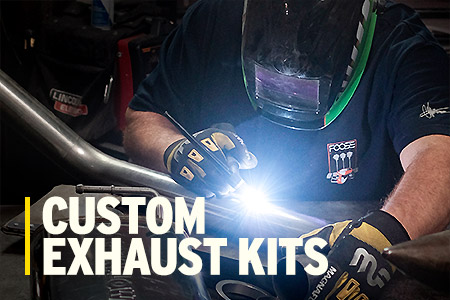
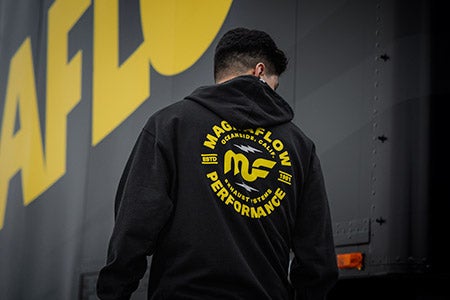
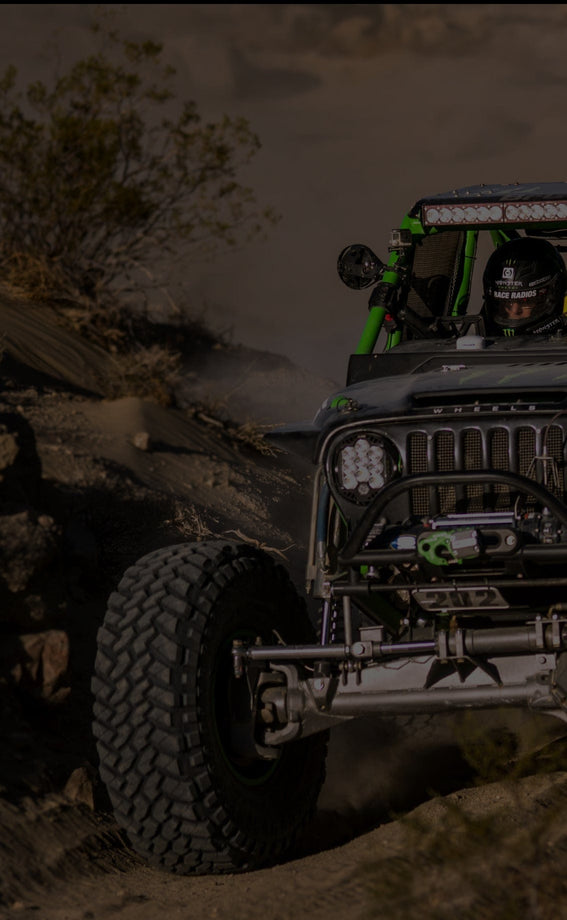

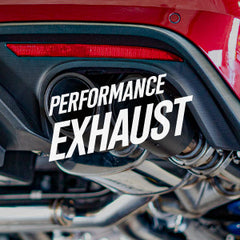
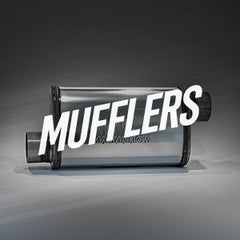


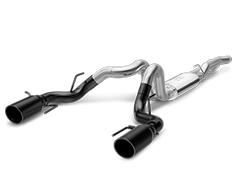
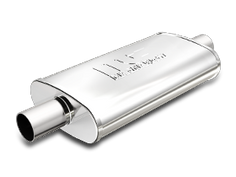
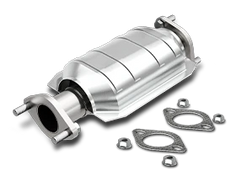
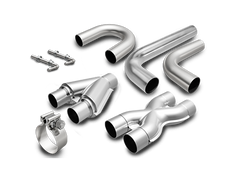
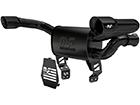





Comments